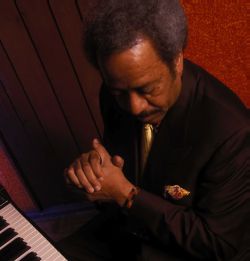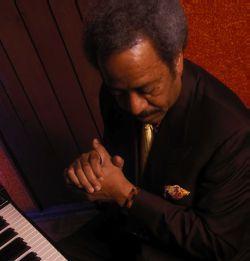
In a city celebrated for spawning generations of music for the rest of the country, and the world, 73-year-old Allen Toussaint can claim more than a half-century’s worth of parental pride. Signed as a young man by RCA Victor, Toussaint brought to his songwriting and arranging a joyful, jangly syncopation evocative of the Mardi Gras and second-line parades of his native New Orleans. His songs scored hits both for other artists in that city, including Irma Thomas, Lee Dorsey, and the Neville brothers, and for such outside admirers as the Yardbirds, the Rolling Stones, and Glen Campbell, who topped Pop, Country, and Adult-Contemporary charts in 1977 with Toussaint's exquistiely poetic Southern Nights. Penning other ear-catching '70s hits for Patti LaBelle (Lady Marmalade, about a New Orleans streetwalker) and the Bay Area's Pointer Sisters (the activist anthem Yes We Can Can), Toussaint also served as a dynamic and sympathetic producer, while continuing to record as a singer and pianist under his own name. Although he was forced by Katrina to temporarily relocate to the Big Apple, he maintained his base in the Big Easy through the decades. And he’s continued to network with younger musicians, while playing benefits for survivors of the hurricane and showcasing the sounds of his city on tour. Toussaint spoke with SFCV during a stopover last Saturday, to open this year’s Stanford Jazz Festival.
You’re performing solo here at Stanford and later this summer in Europe. What’s on your set list?
Well, I’ll be doing some of the songs that sort of put me on the map, that were made famous by other people. Of course, I’m gonna do Southern Nights.
Which is the best thing Glen Campbell ever sang.
Well, thank you very much, sir! And I’ll be doing Get Outta My Life, Woman and I’ll Take a Melody, which were made popular by Jerry Garcia. Also I’ll do some of the very old things, like Mother-on-Law [recorded in 1961 by New Orleans’ Ernie K-Doe]. And stuff off the CD that was produced by Joe Henry [The Bright Mississippi, Nonesuch Records, 2009], like the title tune, which is similar to Sweet Georgia Brown but was written by Thelonious Monk, and Django Reinhardt’s Blue Drag.
Featured Video
Related Article
Music Brings a City Back: New Orleans and Treme
In this SFCV-exclusive video, Kermit Ruffins and Big Sam Williams talk about New Orleans music and Katrina.
When you arrange someone else’s song, what’s in the Toussaint touch?
Whatever makes me “New Orleans,” you’d hear it. I do something in my show about what went into making me who I am. I play the different things I heard as a kid: I must say, a whole lot of Professor Longhair [the stage name of seminal pianist and singer Henry Roeland Byrd, who died in 1980]. And also some of the Mardi Gras Indian music; that was always a heavy influence on all of us, that frenzied kind of beat they did, a whole lot of percussion poppin’ everywhere. On the radio, I heard a lot of hillbilly music. I used to like the way the saloon pianists had all those trills going on. Of course, boogie-woogie really got to me. And even some gospel.
Did you play in church?
No, I came up very Catholic, and that music was very complicated. But I did latch onto gospel, off the radio and records.
Did anything classical catch your ear?
I liked all of the classics. I liked Vivaldi, Verdi, Wagner, Puccini — everyone. Because they sounded like one big beautiful thing sent from heaven.
Any influences on your piano from outside New Orleans?
Definitely. I liked boogie-woogie, Albert Ammons. I loved Ray Charles, as well, and I really liked Liberace: He could look at you and smile, like he wasn’t the one playing all that amazing stuff. And of course when I heard Dave Brubeck and Art Tatum, I was shocked!
Floyd Kramer?
I was thinking about him as you were asking that. He was as close as a piano could come to bending notes.
Before Katrina, my whole life was spent in the studio, waiting for the red light. Since Katrina, I’ve been inspired in many different ways — writing loads and loads of songs, from that inspiration.
You were there in New Orleans while rock ’n’ roll was coming up, and there were contributions early on from your city, though not everyone knew who was from there.
Some of the architects were Dave Bartholomew and [his co-songwriter] Fats Domino, Smiley Lewis, Huey “Piano” Smith: people like that. The Caribbean influence was very instrumental in making it what it was.
It’s interesting that a couple of your first hits were popularized by trumpeters, Al Hirt and Herb Alpert.
Well, I wrote Java for piano, really, and then [pianist] Floyd Kramer recorded it, and Boots Randolph told Al Hirt’s manager, “You’d better take a look at this.” I was in the military at that time, and we had a little weekend band, and when they found out I’d written Java, they thought that was the funniest thing in the world, ’cause they thought it was a pretty “popcorn” song. They thought I should have been more R&B than that. So I wrote Whipped Cream, for trumpet, and about 20 other songs like that, just to poke fun back at ’em, and we had to play ’em every night. [Whipped Cream became the title tune for a 1965 chart-topping album by Herb Alpert.]
How much of what you’re doing now is done out of New Orleans?
Everything. Since Katrina, I’ve been doing something different in my life, because before Katrina, my whole life was spent in the studio, waiting for the red light. Since Katrina, I’ve been inspired in many different ways — writing loads and loads of songs, from that inspiration.
You’ve referred to the hurricane as your “agent.”
Katrina made us change our complacency, get out of town, and stop doing whatever we were doing. I migrated to New York, and we did a series of benefit concerts, and [pop performer and songwriter] Elvis Costello and I connected right away. We were on several benefits together, then we decided to actually record together. Elvis said he’d always wanted to do an Allen Toussaint songbook, and I jumped at the opportunity. So we did The River in Reverse album [Verve, 2006], and we started touring. We went many places around the world, and that’s been a giant step in my career.
Where did the money go?
It did go to the rebuilding of New Orleans, and I must say we saw where the money was going. It didn’t stop at a front desk anywhere.
What did the album title mean for you?
That when it’s time for men to act with each other, in times of need, we need to turn things around. From where they were going, if they weren’t working, turn ’em in reverse.
And is New Orleans recovering?
It’s all there, blooming. There’s so many improvements that we wouldn’t have had, if it hadn’t been for Katrina. We had become complacent, like most places, settling for whatever was. But there’s many, many improvements now, since we had to flex new muscle.
Is the music strong?
The links of the chain are in good shape. We still have a lot of good traditional-jazz youngsters coming along, like Trombone Shorty. And there’s still some good R&B being played. And, of course, the street musicians, who are right out in front of the [St. Louis] Cathedral and Jackson Square right now. You can still hear what made New Orleans New Orleans.
I saw you a couple of weeks ago in an episode of HBO’s Treme series on TV, which is set in your city.
I think there were two episodes I was on. We’re really glad Treme is happening, because it’s bringing some added attention to New Orleans. I didn’t have much to do [on the show], believe me: That is not my comfort zone. I was just playing a bandleader ... and if you take me away from that, I’m dead.
Has Treme stayed true to the music?
They’re actually using the true musicians from there. Deacon John [Moore] is not only playing guitar, but being a character in the series. And many of the guys on the soundtrack [on Geffen Records] have speaking parts. It’s just saturated with New Orleans.

